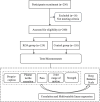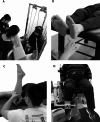Balance Control is Sequentially Correlated with Proprioception, Joint Range of Motion, Strength, Pain, and Plantar Tactile Sensation Among Older Adults with Knee Osteoarthritis
- PMID: 38853218
- PMCID: PMC11162994
- DOI: 10.1186/s40798-024-00735-3
Balance Control is Sequentially Correlated with Proprioception, Joint Range of Motion, Strength, Pain, and Plantar Tactile Sensation Among Older Adults with Knee Osteoarthritis
Abstract
Background: Patients with knee osteoarthritis (KOA) are at high risk for falls, which is attributed to their impaired balance control. Identifying factors associated with balance control facilitates the development of precise KOA rehabilitation programs. This study was to investigate the correlations of balance control with proprioception, plantar tactile sensation (PTS), pain, joint range of motion (ROM), and strength among older adults with and without KOA, as well as the magnitudes and sequence of correlation of these factors to balance control.
Methods: A total of 240 older adults with (n = 124, female: 84, age: 68.8 ± 4.0 years) and without (n = 116, female: 64, age: 67.9 ± 3.5 years) KOA were recruited and assigned to the KOA and control groups. Their proprioception, PTS, pain, ROM, and strength were measured. Pearson or Spearman correlations were used to test whether they were significantly related to their Berg Balance Scale (BBS), and factor analysis and multivariate linear regression were used to determine the degrees of correlation between each factor and the BBS.
Results: Compared to the control group, the KOA group had lower BBS score, larger proprioception and PTS thresholds, smaller ROM, and less strength (p: 0.008, < 0.001-0.016, < 0.001-0.005, < 0.001-0.014, and < 0.001-0.002, respectively). In the KOA group, the BBS was weakly to moderately correlated with proprioception, PTS, pain, ROM, and strength (r: 0.332-0.501, 0.197-0.291, 0.340, 0.212-0.508, and 0.236-0.336, respectively). While in the control group, the BBS was correlated with proprioception and strength (r: 0.207-0.379, and 0.212-0.410). In the KOA group, BBS = 54.41+ (0.668*strength) - (0.579*PTS) - (1.141*proprioception) + (1.054* ROM) - (0.339*pain). While in the control group, BBS = 53.85+ (0.441*strength) - (0.677*proprioception).
Conclusion: Worse proprioception and PTS, smaller ROM, and less strength were detected among older adults with KOA, and their proprioception, PTS, pain, ROM, and strength were all related to balance control. Proprioception had the strongest correlations, followed by ROM, strength, pain, and PTS. Precise KOA rehabilitation programs may be proposed following the sequence of improving the five factors.
Keywords: Berg Balance Scale; Fall; Multivariate Linear Regression; Risk Factors.
© 2024. The Author(s).
Conflict of interest statement
Peixin Shen, Simin Li, Li Li, Daniel T.P. Fong, Dewei Mao, and Qipeng Song declare that they have no competing interests.
Figures



Similar articles
-
Balancing sensory inputs: somatosensory reweighting from proprioception to tactile sensation in maintaining postural stability among older adults with sensory deficits.Front Public Health. 2023 May 4;11:1165010. doi: 10.3389/fpubh.2023.1165010. eCollection 2023. Front Public Health. 2023. PMID: 37213635 Free PMC article.
-
Relationship between proprioception and balance control among Chinese senior older adults.Front Physiol. 2022 Dec 15;13:1078087. doi: 10.3389/fphys.2022.1078087. eCollection 2022. Front Physiol. 2022. PMID: 36589414 Free PMC article.
-
Relationship of proprioception, cutaneous sensitivity, and muscle strength with the balance control among older adults.J Sport Health Sci. 2021 Sep;10(5):585-593. doi: 10.1016/j.jshs.2021.07.005. Epub 2021 Jul 20. J Sport Health Sci. 2021. PMID: 34293496 Free PMC article.
-
The effects of total knee arthroplasty on knee proprioception of patients with knee osteoarthritis: a meta-analysis.J Orthop Surg Res. 2022 May 7;17(1):258. doi: 10.1186/s13018-022-03142-0. J Orthop Surg Res. 2022. PMID: 35526039 Free PMC article.
-
Effect of strength training on knee proprioception in patients with knee osteoarthritis: A systematic review and meta-analysis.Sports Med Health Sci. 2023 Nov 7;6(2):101-110. doi: 10.1016/j.smhs.2023.10.005. eCollection 2024 Jun. Sports Med Health Sci. 2023. PMID: 38708322 Free PMC article. Review.
Cited by
-
The common link between sleep apnea syndrome and osteoarthritis: a literature review.Front Med (Lausanne). 2024 Aug 21;11:1401309. doi: 10.3389/fmed.2024.1401309. eCollection 2024. Front Med (Lausanne). 2024. PMID: 39234045 Free PMC article. Review.
References
Grants and funding
LinkOut - more resources
Full Text Sources

